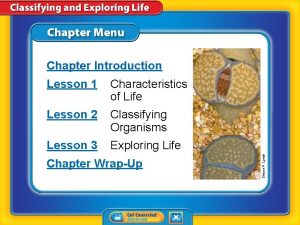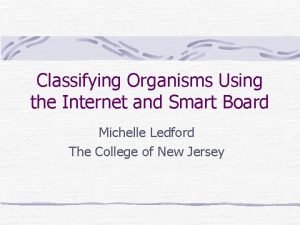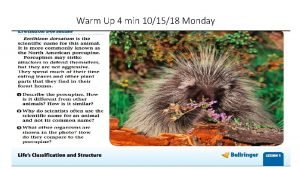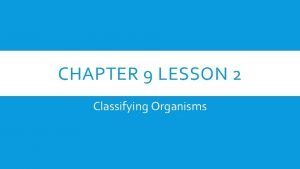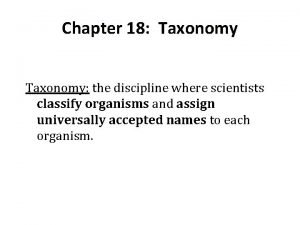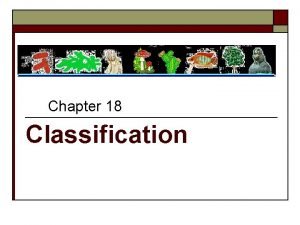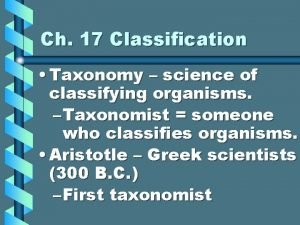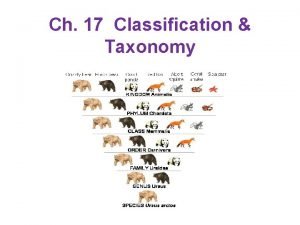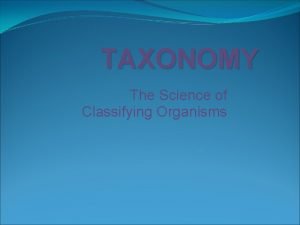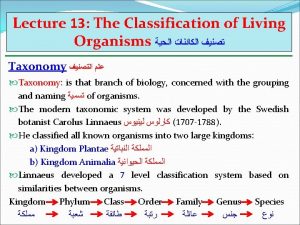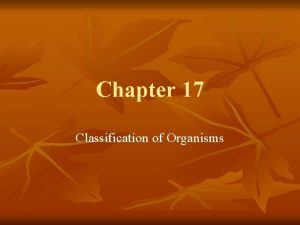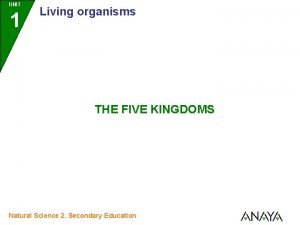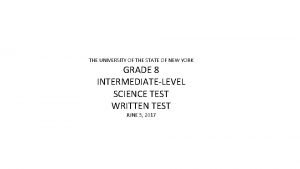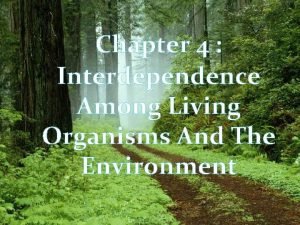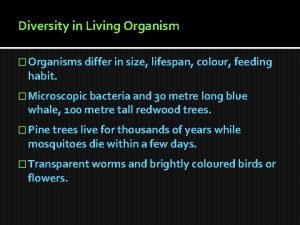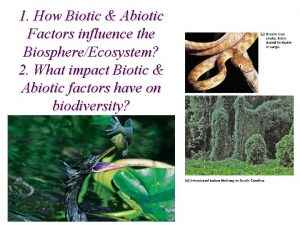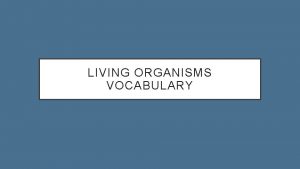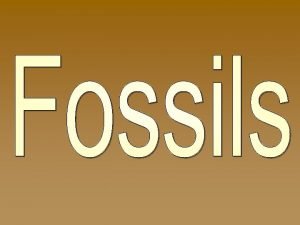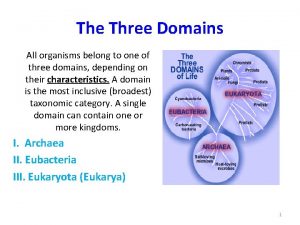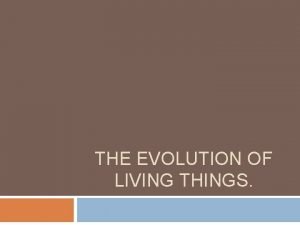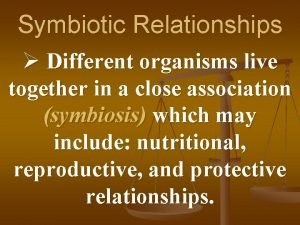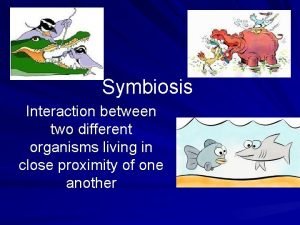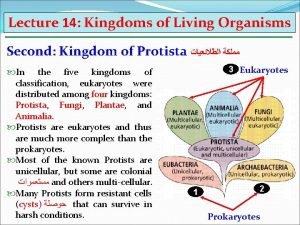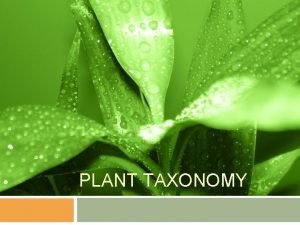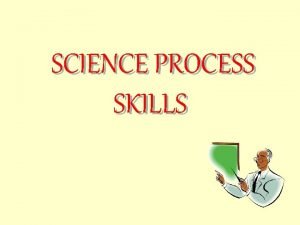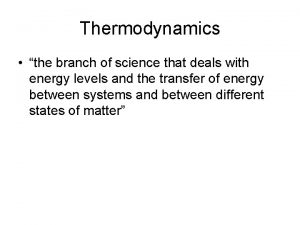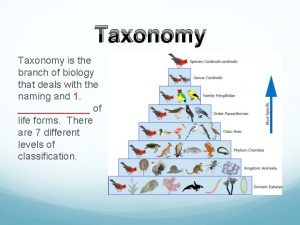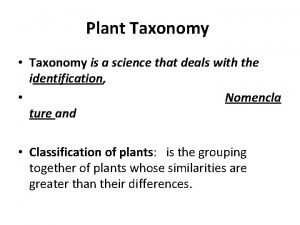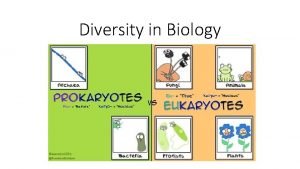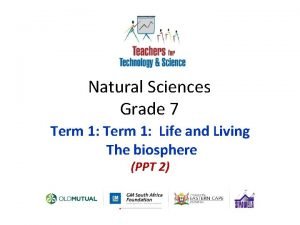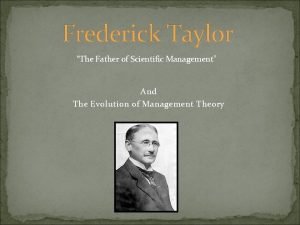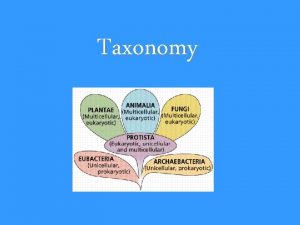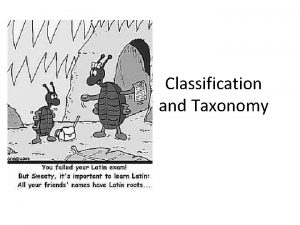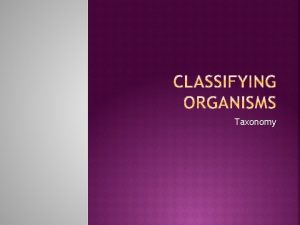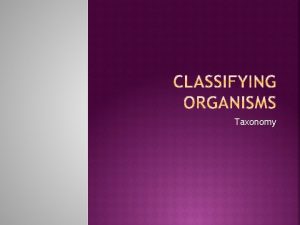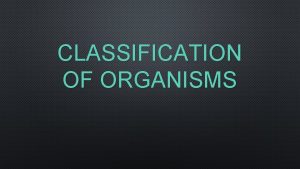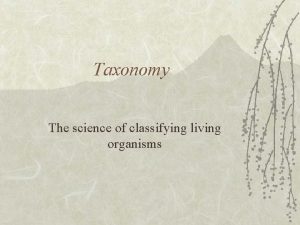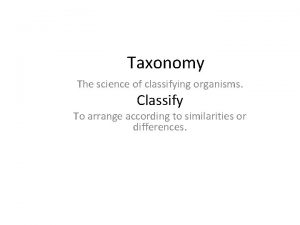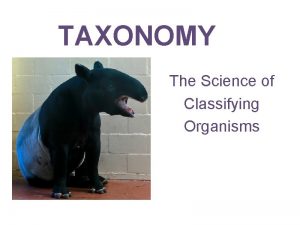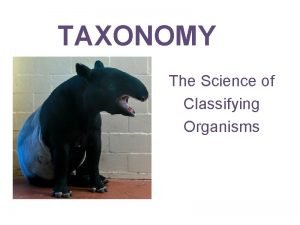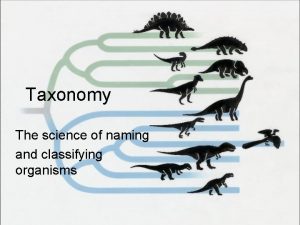Taxonomy Science of Classifying Living Organisms Father of
































































- Slides: 64

Taxonomy Science of Classifying Living Organisms

“Father of Taxonomy” – Carolus Linnaeus (Swedish Botanist) • He set up the system we use today • He recognized species on the basis of structural similarity • He gave them scientific names made up of Latin words

Linnaeus’s Naming System • This system is called binomial nomenclature (two-word naming) • The first word is the genus (which is always capitalized) and the second is the species • Both are underlined or italicized

Members of the same species are similar in structure and can mate to produce a fertile offspring

Celebrities!! • http: //www. popular mechanics. com/scien ce/animals/a 4464/432 3547/ • http: //news. discovery. com/animals/caziestnew-animal-speciesof-2015 -photos 150521. htm • http: //listverse. com/2 012/12/12/10 incredible-recentlydiscovered-animals/

Six-kingdom System (in order from the least complex) Kingdom Archaebacteria Kingdom Eubacteria Prokaryotic Kingdom Protista Kingdom Fungi Kingdom Plantae Kingdom Animalia Eukaryotic

Groupings in classification (starting with the largest) Kingdom Phylum Class Order Family Genus (genera – plural) Species

For example - classify man: Kingdom - Animalia Phylum - Chordata Subphylum - Vertebrata Class - Mammalia Order - Primates Family - Hominidae Genus - Homo Species - sapiens Scientific name of man - Homo sapiens (wise one)

Symmetry - general form of an organism 3 basic types: (except in snails and amoeba which are asymmetrical) 1. spherical - a ball (sphere) any axis through the center will divide in half 2. radial - axes radiate like the spokes of a wheel 3. bilateral - 2 sided axis will divide into similar halves one side is a mirror image of the other

Types of Symmetry: Spherical Asymmetrical Radial Bilateral

The Prokaryotes Kingdoms Archaebacteria and Eubacteria Characteristics: 1. most numerous organisms on Earth 2. most ancient organisms 3. microscopic 4. prokaryotic – no true nucleus pro – before karyo – nucleus


Kingdom Archaebacteria • found in extreme, harsh environments • do NOT contain the carbohydrate peptidoglycan in the cell walls • 3 Broad Groups

1. Methanogens – get energy by converting H 2 and CO 2 into methane gas • anaerobic – do not require oxygen • live in the bottom of swamps, in sewage (form of marsh gas), and in intestinal tracts of humans and other animals Wolinella succinogenes (Bacteria) This bacterium lives in the rumens of cows and is related to two microbes that cause stomach disorders in people, Helicobacter pylori and Campylobacter jejuni. Scientists had thought the bacterium was harmless to people, but the genome project revealed genes that may be used to cause disease.

2. Extreme halophiles – use salt to generate ATP (cellular energy) • live in areas of very high salt concentrations ex. Great Salt Lake and Dead Sea Halophiles have turned the land that surrounds the Great Salt Lake in Utah a reddish color. This happens to the land after flood water spreads onto the land.

3. Thermoacidophiles – live in areas of extremely acidic environments that have extremely high temperatures ex. hot springs, volcanic vents, hydrothermal vents Hyperthermophiles produce some of the bright colors of Grand Prismatic Spring, Yellowstone National Park

Kingdom Eubacteria -found everywhere • contain the carbohydrate peptidoglycan that makes up the cell wall

3 Shapes of the Eubacteria a. bacilli – rod-shaped b. cocci – sphere-shaped in chains – streptococci in grapelike clusters – staphlococci c. spirilla – spiral-shaped


Some functions of bacteria: 1. decomposers – break down dead organisms to recycle nutrients 2. nitrogen fixers – plants can only use nitrogen in a certain form in order to grow – bacteria in soil convert nitrogen to that form

3. disease – can cause disease by breaking down tissue for food or releasing poisons that harm the body • tuberculosis, food poisoning, strep (streptococci) 4. food products – bacteria help to make some foods that we value • cheese, yogurt, buttermilk, sour cream, pickles, and sauerkraut

Fungi Bacteria

5. industry a. digest petroleum – clean up oil spills b. remove waste products and poisons from H 2 O c. help minerals from the ground d. synthesize drugs/chemicals through genetic engineering 6. controlling bacteria a. sterilization b. refrigeration, steaming c. canning

Viruses Virology – the study of viruses Characteristics: a. nonliving b. composed of nucleic acid and a protein coat c. smaller than bacteria d. cause disease in living organisms Major divisions focus on genetic material: 1. DNA viruses 2. RNA viruses

DNA Viruses • Divided by the shape for their protein coats and their sizes • capsid – the protein coat surrounding the nucleic acid • The protein in the capsid “tricks” the host cell into allowing the virus. Once inside it takes over, putting the genetic program of the virus into effect.

A Bacteriophage (my personal fav)

RNA Viruses



Common diseases caused by viruses: Polio, measles, AIDS, mumps, influenza, yellow fever, rabies, common cold, cancer

Cases of Polio

Fighting Viral Diseases https: //www. youtube. com/watch? v=u. FXux. Gu. T 7 H 8 • Vaccines – weakened or killed virus or viral protein • Body produces antibodies that protect you from future invasions

Kingdom Protista • Any organism that is not a plant, animal, fungus or prokaryote • Includes protozoans and algae

Protista Characteristics • One-celled or multicellular, solitary or in a colony (colonial) • Many are microscopic (most are) • Contain organelles – no tissues or organs • Moist environment • Locomotion (if any): – Cilia (hair-like) – Flagella (whip-like) – Pseudopod (false foot)

Cilia (Paramecium caudatum)

Flagella – Euglena gracias

Pseudopod – Amoeba proteus

Algal Bloom in Australia November 2012

Important Protists 1. Phylum Sarcodina Amoeba eating two paramecium • move by pseudopods – cytoplasmic streaming • surround their food to ingest it into food vacuole • reproduce by binary fission ex. amoeba

2. Phylum Ciliophora • move using cilia • free-living • reproduce: sexually - conjugation asexually – binary fission ex. paramecium

3. Phylum Zoomastigina • move using flagella • feed on decaying organic matter; some are parasitic • reproduce asexually – binary fission ex. trypanosomes

4. Phylum Sporozoa • no means of locomotion • ex. Plasmodium – causes malaria • reproduce asexually by spores – produce sporozoites that attaches to, enters, and lives off of host cell

Diseases Caused by Protists 1. Malaria • caused by the sporozoan, Plasmodium • carried by the female Anopheles mosquito • known as the “Chills and Fever” Disease • http: //www. who. int/g ho/en/

Mosquito salivary glands (sexual stage) spores in blood (10 -20 spores per RBC) spindle shaped in stomach of mosquito Man’s RBC’s (Malaria) (asexual stage)

Lifecycle of Malaria

2. African Sleeping Sickness • caused by the trypanosome – Trypanosoma gambienese • carried by the tsetse fly • causes fever, swollen glands, anemia if in blood • coma or death if in CNS • life cycle is similar to malaria

3. Amoebic Dysentery • caused by the amoeba – Entamoeba histolytica • transmitted by contaminated drinking water • affects tissues of the intestinal wall causing ulcers and extreme diarrhea • cysts in solid wastes (excreted in feces) • common in areas with no sewage treatment or when human wastes are used as fertilizer • causes dehydration

Plant-like protists make up phytoplankton • major part of the oceans food web

Euglena

Dinoflagellates

Green Algae

Brown Algae

Red Algae

Golden-brown Algae

Kingdom Fungi Characteristics • Eukaryotic • Heterotrophic • Unicellular/ multicellular • Cell walls usually of chitin • Mostly decomposers • Some parasites • Some commensal or mutualistic • Ex. YEAST!

• Examples: mushrooms, puffballs, rusts, smuts, bracket fungi

Some mushrooms are edible; some are poisonous - no reliable simple distinction Amanita Blusher (edible) Destroying Angel (deadly)

Fungi as heterotrophs feed on decaying matter Fungi as decomposers recycle nutrients

Fungi as parasites cause: Plant diseases such as corn smut, mildew, wheat rust

Human diseases such as athletes foot, , ringworm, yeast infections

Symbiotic Relationships: Mutualism – symbiosis in which both organisms benefit 1. Lichen – mutualistic relationship between a fungus and a green alga or cyanobacterium

• indicators of air pollution • pioneer plants

2. Mycorrhiza – mutualistic association between fungus and plant roots

• occur in over 90% of plants • fungus increases surface area to help plants absorb water and nutrients • fungus receives some sugar from the plant
 Kingdom phylum class order
Kingdom phylum class order Canis latrans classification
Canis latrans classification Pyramid hesd
Pyramid hesd Hierarchy of classification
Hierarchy of classification Lesson 2 classifying organisms answer key
Lesson 2 classifying organisms answer key Classifying organisms worksheet
Classifying organisms worksheet Lesson outline classifying organisms
Lesson outline classifying organisms Lesson 2 classifying organisms
Lesson 2 classifying organisms Discipline of classifying and naming organisms
Discipline of classifying and naming organisms Discipline of classifying and naming organisms
Discipline of classifying and naming organisms Why do scientists classify organisms?
Why do scientists classify organisms? When classifying organisms orders are grouped together into
When classifying organisms orders are grouped together into Discipline of classifying and naming organisms
Discipline of classifying and naming organisms Classification groups in order
Classification groups in order Marzano verbs
Marzano verbs Organisms taxonomy
Organisms taxonomy Organisms taxonomy
Organisms taxonomy Name of organisms
Name of organisms Organisms taxonomy
Organisms taxonomy Taxonomy in biology
Taxonomy in biology Competitive interaction
Competitive interaction Unicellular vs multicellular
Unicellular vs multicellular Classifying living things lesson 1 answer key
Classifying living things lesson 1 answer key Examples of animal organs
Examples of animal organs Why do amebas need to obtain food
Why do amebas need to obtain food Are all living things based on the metric system
Are all living things based on the metric system Fungi cell
Fungi cell Interdependence among living organisms
Interdependence among living organisms Living organisms differ in
Living organisms differ in Living organisms and their surroundings
Living organisms and their surroundings Two different organisms living together
Two different organisms living together Examples of the 6 kingdoms
Examples of the 6 kingdoms What is the smallest unit of living organisms
What is the smallest unit of living organisms Living organisms
Living organisms Remains, imprints or traces of once-living organisms
Remains, imprints or traces of once-living organisms Three domains of life
Three domains of life Evolution of living organisms
Evolution of living organisms Two different organisms living together
Two different organisms living together Guinea worm
Guinea worm Small living creatures tom
Small living creatures tom Kingdom protists
Kingdom protists Remains imprints or traces of once-living organisms
Remains imprints or traces of once-living organisms Smallest living unit
Smallest living unit Copyright
Copyright Genus example
Genus example What are your favorite subjects?
What are your favorite subjects? Processing skills in science
Processing skills in science Science process skills definition
Science process skills definition Moss living or nonliving
Moss living or nonliving Living non living dead
Living non living dead Thermodynamics is a branch of science which deals with
Thermodynamics is a branch of science which deals with Study of plants
Study of plants Taxonomy is a branch of science which
Taxonomy is a branch of science which Taxonomy is the science that deals with
Taxonomy is the science that deals with Crayfish taxonomy
Crayfish taxonomy Grade 7 natural science term 1
Grade 7 natural science term 1 Science for sustainable living
Science for sustainable living Forensic science timeline
Forensic science timeline Who is called father of scientific management
Who is called father of scientific management He is the father of life science
He is the father of life science Natural vs social science
Natural vs social science Branches of biology
Branches of biology Natural and physical science
Natural and physical science Applied science vs pure science
Applied science vs pure science Rapid change
Rapid change




